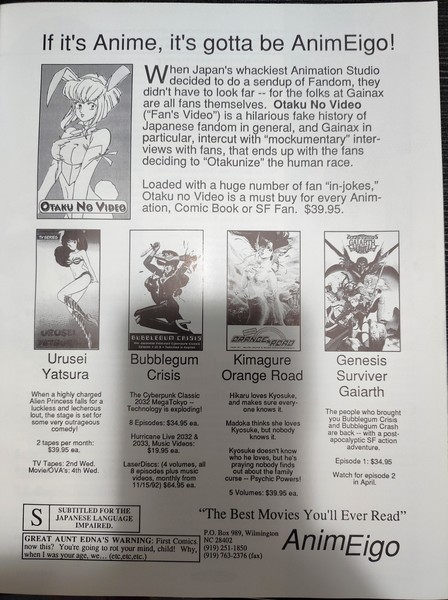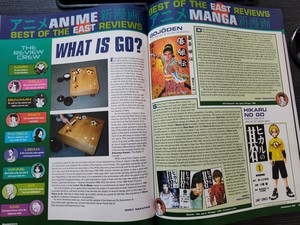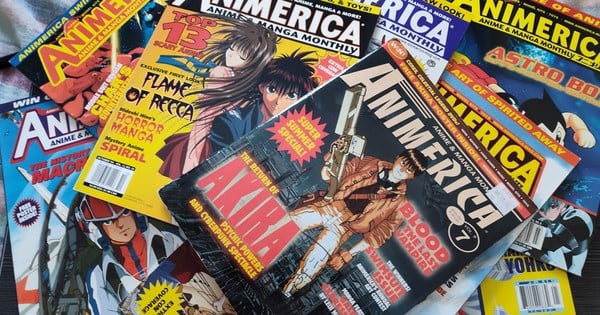Curated From www.animenewsnetwork.com Check Them Out For More Content.
My first contact with anime was during my college years. I used to scour the web and look through the tiny manga section at my local bookstore in search of information. One day, a particular publication in that store’s magazine section caught my eye. It was called Animerica. Flipping through the pages, I found a wealth of information on the newest anime series at my fingertips. I eventually went on to discover my college’s anime club, and anime became more prevalent on TV. However, I still relied on Animerica for news and to explore any other anime and manga titles I might have been interested in. When the magazine folded in 2005, I knew I still had other sources, but I lost something significant.

© Anime News Network
Animerica was the brainchild of Satoru Fujii and Seiji Horibuchi, the founders of Viz Communications, now known as Viz Media. Horibuchi and Trish Ledoux joined Fujii as co-editors at launch with financial backing from Japanese publisher Shogakukan. Viz had some success with manga since the end of the 1980s, but the two felt they needed a consistent way to promote anime and manga. Viz turned to San Francisco-based fanzine Animag staffers Ledoux and Mark Simmons to fill out the magazine’s staff roster.
This staff had trouble during the planning stages trying to determine what path they wanted to take the magazine: A safer route by catering to an already established anime fandom (with the downside being that, once the saturation of that fanbase was achieved, circulation would be limited) or taking risks to reach a market that would be in better tune with the staff’s experience as anime fans where it wouldn’t be necessary to be an expert to enjoy domestic releases.
The staff settled on the latter option and designed the publication with content for every anime or manga fan regardless of age or level of sophistication. In 1997’s Anime Interviews: The First Five Years of Animerica Anime & Manga Monthly (1992–97) the Animerica editors wrote, “In effect, what we wanted to create with Animerica was an anime version of Premiere or Film Threat, a magazine devoted to and written for fans of Japanese animation—all fans, and all Japanese animation—no matter what their age or gender might be.”
Viz released the low-run preview issue of Animerica in November 1992, followed by its first full issue in February 1993. In the preview issue, Horibuchi wrote that the magazine was created “with a sincere belief in the need for cross-cultural communication, that which makes our lives richer and helps people to understand each other better.” Horibuchi also stated that the magazine’s position as a conduit between Japan and America would allow the reader to obtain information that was once available to an elite few.
Unfortunately, very little anime was released domestically at the time. With the first regular issue released in February 1993, the writing team began covering titles, which at that time, were not officially available in North America, such as that month’s feature on Mobile Suit Gundam 0083: Stardust Memory (it wasn’t released in North America until 1999 on VHS and not on TV and DVD until 2002).
Thanks to connections to Japanese publishers Shueisha and Shogakukan, Animerica was able to feature properties owned by them, like Ranma ½. Some of the magazine’s staff translated and edited manga for Viz, including Ledoux, who wrote insert features in a Ranma ½ article explaining how the team figured out the opening theme’s translation. Viz was also releasing Ranma ½ and other anime on VHS and advertised the magazine with other Viz titles near the end of the tape.
An average magazine issue included news from Japan and the U.S. about upcoming releases. Early issues even had summaries of that month’s Japanese magazine counterparts, such as Newtype and Animage. There were monthly rankings and street dates for Japanese and North American anime releases (in VHS, Laser Disc, and eventually DVD) and manga. By the end of the 1990s, the magazine phased out the Japanese release dates and, by the early 2000s, the rankings. This left only the American release dates and rankings. The magazine included brief articles about recent anime conventions (with accompanying photos of cosplayers), describing notable developments and other facts. One issue reported that now-mega convention Anime Expo had 1200 people attend in what was a record-breaking showing for 1997.
Reviews for domestically-released anime, and eventually manga, were under a section entitled Best of the West. Best of the East covered anime and manga titles only available in Japan. The magazine also reviewed domestic and imported video games on systems ranging from the PC Engine to the PlayStation 2 and everything in between. There were also reviews of music that started with soundtracks to various anime and video games and, by the magazine’s end, also covered albums from Japanese music groups.

© Anime News Network
There were several columns throughout the magazine. Animerica launched with “From the Forest,” written by anime journalist Takashi Oshiguchi. He was once the manager of Manga no Mori (“Comics Forest”) manga shop, where he discussed various subjects such as what manga or anime he was following at the time. Early issues also included “Hud’s View,” by comic book writer James D. Hunall, where he gave an insider’s take on the anime and manga industry as it was at the time.

© Anime News Network
As anime and manga fans delved deeper into their hobby, they discovered other aspects of otaku and Japanese culture to learn about and could turn to Animerica to provide that content. The staff added columns to reflect these newfound interests, such as model building and Mark Simmons‘ column, where he reviewed model kits, most of which were gunpla. Patrick Macias, who is now an editor at Otaku USA, wrote about tokusatsu and other Japanese live-action films and television shows in his “Tokyoscope” column. In its final years, the magazine had columns on elements of cosplay. There were regular dispatches from multiple contributors who spent some time living in Japan, giving an on-the-ground account of daily life there.
Animerica had a fan art theme for every issue, from “pirates” to “ninja,” where the artists draw their favorite characters as these concepts (and the most reoccurring theme is unsurprisingly “swimsuits”). The letters section often contained thoughts from the readers on articles from previous issues asking for more information or those looking to correspond with other readers.
There were also little things that dotted an issue that gave it a sense of charm, such as having illustrations of the reviewers or little messages at the bottom of the issue’s masthead, usually a quote from one of the anime featured in that issue or what music some of the staff had been listening to recently. There was even a feature that ran in the late ’90s called “Fun with Porken Beans,” which included little humorous pieces such as how to draw Misato from Evangelion (complete with beer can in hand) or taking Sailor Moon through a maze while avoiding hazards such as Queen Beryl and a McRib Extra Value Meal.
One of the magazine’s defining hallmarks and major achievements in fandom history was its in-depth interviews with various anime and manga creators and English dub actors. To give a partial list of creators and artists wouldn’t do the range of interviews justice. Suffice it to say Animerica interviewed many of the industry’s greats who made their mark between 1975 and 2000 (and some of them multiple times). Viz collected and released these interviews from the early years in the previously mentioned Anime Interviews: The First Five Years of Animerica, Anime & Manga Monthly (1992-97).
Like any magazine, Animerica had its fair share of advertisements. Of course, there were ads from the various anime distributors trying to sell their latest acquisitions (surprisingly, ads for hentai titles on occasion) and ads for video games and upcoming anime conventions. At the same time, there were ads for various hobby shops ranging from selling anime on video tape complete with order forms to goods such as model kits and posters. Order forms and toll-free telephone numbers gave way to e-mail addresses and websites. As the years passed, these businesses’ ads disappeared and Animerica didn’t exactly replace them either. Only ads for the leading distributors and retailers remained by the final issues.

© Anime News Network
A final feature worth noting is that from the magazine’s beginning to around 2002, it had one or two serialized manga series within its pages. The staff planned these serializations as a way to introduce short stories and more off-beat manga titles they believed wouldn’t do well as stand-alone comic books (during the 1990s through the early 2000s, most manga were first released one or two chapters at a time in a single comic book similar to Marvel or DC releases). Titles included Rumiko Takahashi works like Urusei Yatsura, Mermaid Forest, and One-Pound Gospel. Area 88 by Kaoru Shintai, AD Police by Tony Takezaki, the manga short of Porco Rosso by Hayao Miyazaki before it was turned into a film, and Galaxy Express 999 by Leji Matsumoto also graced the magazine’s pages.
Along with this feature in the main magazine, Viz released a sister publication entitled Animerica Extra in 1998. Billed as “the anime fan’s comic magazine,” it showcased several titles per issue in serialized chapters, much like their original format in Japanese manga magazines. The titles presented were diverse, though they tended to focus on shojo (and would come to be the magazine’s focus towards the end of its run). The titles range from Chiho Saitō‘s take on Revolutionary Girl Utena, Fushigi Yûgi by Yuu Watase, Steam Detectives by Kia Asamiya, Maison Ikkoku by Rumiko Takahashi, and Video Girl Ai by Masakazu Katsura. The magazine folded at the end of 2004, and Viz replaced it with Shojo Beat. Shojo Beat would itself end in 2009.
Besides Anime Interviews: The First Five Years of Animerica, Anime & Manga Monthly (1992-97), the magazine spawned two other books: Gundam Official Guide and The Best of Animerica: 2003 Edition. Compiled from a special edition Animerica magazine, Gundam Official Guide was published in 2002. As the title states, the book is a general guide to the Gundam franchise from its beginnings in 1979 to the year 2000. It covers the various anime series, the world and politics these stories inhabit, and various merchandise such as model kits and video games. While it is no longer up to date, it is still one of the best references to the franchise in English, covering the early years. Viz released The Best of Animerica: 2003 Edition in March 2003 and it is a collection of feature articles from the magazine in 2001 and 2002.

© Anime News Network
By 2002, the magazine was at its height, but there were signs indicating that things were beginning to change. Anime on TV was increasing on several channels, but the booms brought on by the Sailor Moon and Pokémon franchises had faded. Both manga and anime had become ubiquitous on the shelves of both book and video stores, yet that also meant that people didn’t need a magazine to learn what this stuff from Japan was all about. For those who wanted information, the internet was becoming sophisticated enough to make that information, whether from an official site or fan sites on Anipike or even the site you are reading this article on, accessible to anyone in a few keystrokes. Even in the realm of print, Animerica had competition from the likes of Wizard’s Anime Insider and ADV‘s Newtype USA, which began in 2001 and 2002 respectively (both would share Animerica‘s fate and fold by the end of the decade).

© Anime News Network
It was also becoming quite clear that the anime industry was changing on a fundamental level. It was no longer a cottage industry with small dubbing studios and mom-and-pop retailers but divisions of larger companies and big box stores. As one-time editor Julie Davis said, “The glory days of the anime boom were changing into something else, something driven by marketing and sales.” The Editorial in the August 2002 issue admitted these changes as Davis wrote that the magazine must provide context and opinion along with providing information. Davis also suggested that their Best of the East section needed to be revamped as the time gap between an anime’s Japanese and Western release had shortened significantly. Changes were made across the magazine, but in April 2005, staff announced that the retail edition of the magazine would fold with the June issue.
While Viz released the final issue in June 2005, it was not the end of the magazine. Animerica continued on in two uniquely different ways. The first was through special editions of the magazine meant for various conventions such as Anime Expo. The second was in a free quarterly digest-sized version of the magazine that was available at Borders and Waldenbooks bookstores, followed by editions for Best Buy stores.
Like the original edition of the magazine, features included news, release dates for upcoming anime and manga titles, a cover feature, and fan art. However, this new version had only half the original’s page count, missing many of the previously available features. This magazine edition ran through the end of 2007 and vanished entirely afterward.
The final retail issue of the magazine contained a series of essays where past contributors and columnists reflected on their time there in addition to the goodbye messages posted throughout the issue (a far more classy way to do things than what Newtype USA did with their final issue). “In Stercore Invenitor” and reviewer columnist Benjamin Wright wrote one of these essays. Wright stated that “Animerica has always been an academic magazine. This beloved rag has existed to educate its readers on our favorite medium, to illuminate the lesser-known details of its creators and its history. But that’s not the kind of magazine that this new, mass-consumption market wants or needs anymore. But that’s okay too…And after a while, anime and manga will get so big here that there’ll come a need for an academic publication to put it all into context. To make sense of it all. Again.”
It was those last sentences that caught my attention. It felt like I was taking part in creating that context while writing this article. In her Anime Lockdown panel “That 2008 Feeling: Exploring the Era of the 2000s Anime Bubble,” Anime Herald editor-in-chief Samantha Ferreira remarked that the history of anime fandom in the U.S. is mostly oral with the potential for much of it to be forgotten. While it is true that we’re dealing with written materials, much of this could disappear in the future. With the richness of this fandom, I can at least help try to make sense of some of this history by going through the life of this magazine.
Further Reading:
“That 2008 Feeling: Exploring the Era of the 2000s Anime Bubble” Panel by Samantha Ferreira. Anime Lockdown 2023.
Anime Interviews: The First Five Years of Animerica, Anime & Manga Monthly (1992-97) Viz, 1997.
Davis, Julie “An Animerica Retrospective: Thirteen Years in Anime” Animerica V. 13 no. 6 June 2005.

